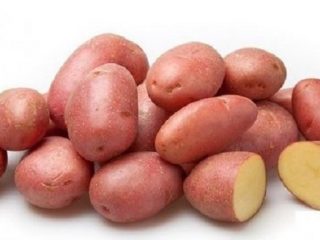Content
Potato varieties for sandy soil are presented in quite a large number. The vegetable crop does not particularly like this soil composition due to its inability to retain moisture, but breeders managed to obtain several plant species suitable for it. Knowing some of the features and nuances of root crop cultivation, it is quite possible to harvest a decent harvest even in sandy soil.

Most of all, potatoes like to grow on loam or sandy loam.
Features of sandy soil
Potatoes are a crop that loves moisture, so when growing them, gardeners try to ensure that the watering of the beds is of high quality. As you know, water does not stay in sand for a long time, which is why scientists decided to develop special potato seeds that are productive on sandy soil. Such varieties tolerate heat more easily, cope with drought, and calmly respond to insufficient amounts of nutrients received. Indeed, in sand there is practically no effect from fertilizing, since water washes out all the necessary substances from it, which settle in the lower layer of soil and do not reach the plant.For this reason, they try to fertilize sandy soil with mineral compounds, and to improve its structure, constantly add humus, peat, silt, clay or drill flour.
Pros and cons of sandy soil
Not all features of sandy soil are negative; it also has quite a few advantages. If you plant plants on it according to technology, the results will be no worse than on any other soil.

The constituent components of such soil are not only sand, but also a small amount of humus and clay
Advantages:
- flowability, facilitating processing;
- rapid erosion process;
- good air flow;
- fast warming up.
Flaws:
- low level of microorganisms;
- lack of moisture;
- need for additional feeding.
Potato varieties for sandy soil
Owners of plots with sandy soil often think about what plants to plant on it. If you want to grow potatoes, it is important to give preference to specially bred varieties that are resistant to drought. It is also worth understanding that a good harvest will require effort. Read on to find out which potatoes are best suited for sandy soil.
Volzhanin
Volganin is a potato variety that produces excellent yields even in hot and dry climates. The tubers have a good ripening speed and are ready for digging within 2.5 months after planting. The taste and keeping quality of the variety are quite good.

Volzhanin potatoes have excellent endurance
Latona
Latona is a Dutch potato variety that is planted on sandy soil, as well as other types of soil. It is unpretentious to weather conditions, brings a good harvest, and has good immunity. The tubers taste good, do not lose their shape during cooking, and last quite a long time.

The Latona variety contains a large amount of starch - up to 20%
Typhoon
Typhoon (Tajfun) is a variety suitable for sandy soil, created by Polish scientists. It is quite popular in many countries, has excellent taste, and grows to large sizes. A special feature of the variety is its powerful and abundantly leafy bushes.

During flowering, Typhoon is covered with large snow-white inflorescences
Red Scarlett
Red Scarlett is a Dutch potato variety suitable for the sandy soil of Russia. It is unpretentious to the type of soil, and is also highly resistant to atmospheric changes and produces a good harvest. The variety is rich in vitamins, macro- and microelements.

The Red Scarlett variety bears fruit approximately 70 days after planting
Rosara
Rosara is a variety that is considered a favorite among gardeners. It has earned great love due to its high yield, excellent taste, and resistance to most diseases. The plant is unpretentious to the vagaries of the weather and feels great on sandy soils.

Rosara has high shelf life
Ramona
Scientists bred the Ramona (Romano) potato variety specifically for regions with hot climates and other conditions unusual for the plant. The tubers of this variety have a good taste and are used for preparing various dishes.

Ramona tastes like Nevskiy potatoes
Gala
Gala - refers to potato varieties for the Moscow region and for sandy soil. It is considered mid-early, ripens in 65-80 days. The tubers have good commercial quality, their weight ranges from 70 to 120 g, and the number of eyes is small.

Gala - table potato variety with excellent taste
Rodrigo
The Rodrigo variety has an attractive appearance. The outside of the potato is red, the inside is creamy. The variety is unpretentious and resistant, can be grown on sandy soil. It is productive, stores well, and is rarely susceptible to disease.

The Rodrigo variety was obtained thanks to the work of German breeders
Growing potatoes in sandy soil
In order for potatoes to grow well in sand, they need to have a specific structure of the root system. It should go deep into the soil and from there be saturated with moisture and nutrients. In addition, it is important to properly organize the care of the crop and carry out planting in accordance with agrotechnical requirements.
Preparing the soil for planting
The main stage of planting potatoes is soil preparation. You should take care of the area in the fall, thoroughly clear it of weeds and dig it up. If the soil is sandy, then it is enough to go deeper by 15 cm, and it is advisable not to turn the layer over. It is also better to apply fertilizing before winter. The ideal solution would be to add manure or compost at the rate of 10 kg per 1 square meter.

It is not recommended to tear up a bed on sandy soil.
Growing potatoes in sand is practiced in different countries, as well as in many regions of Russia.
Planting potatoes in sand
When the weather outside becomes warm enough and the soil warms up to +12-14 °C, which usually occurs in early May, it will be possible to begin planting work. The technology looks like this:
- Furrows are made on the site at a distance of 0.7 m from each other, about 30 cm deep.
- Pour nitroammophoska onto the bottom.
- Mix the fertilizer and soil with a hoe.
- Lay out the sprouted tubers at intervals of 30 cm with the sprouts facing up.
- Covered with earth.
Aftercare
Caring for potatoes on sand, unlike ordinary soil, is much easier. On such soil, thanks to its amazing composition, weeds practically do not grow, and it does not need frequent loosening. Only watering and hilling are required to be done regularly.
The soil should be moistened as it dries, often, especially during the flowering period of the crop, but not excessively, since excess moisture is harmful to the plant. During drought, water from a flat surface evaporates more slowly, so when watering it is more economical to spend it on the holes than to pour it between the ridges.
It is also important to periodically hill up the plantings so that moisture is directed to the roots of the potatoes. In hot weather, if the ridges are high, it is permissible not to pour them in, but only loosen them a little.
It is useful to feed the plantings several times a season. It is best to use chicken droppings or manure diluted in water for this purpose.
Conclusion
Potato varieties for sandy soil were developed taking into account all its nuances. If you plant tuber crops of the desired variety in such soil and take the recommended care for them, the harvest will be large and of high quality. Potatoes of any variety have always been and remain a favorite vegetable of all generations. It has an excellent taste and is available for consumption in various forms.








